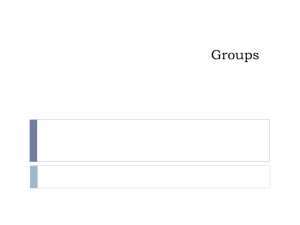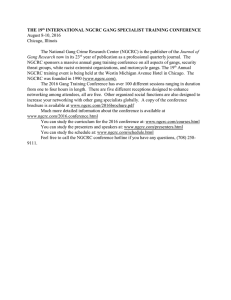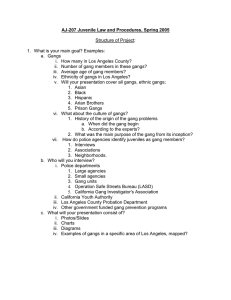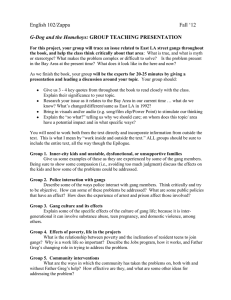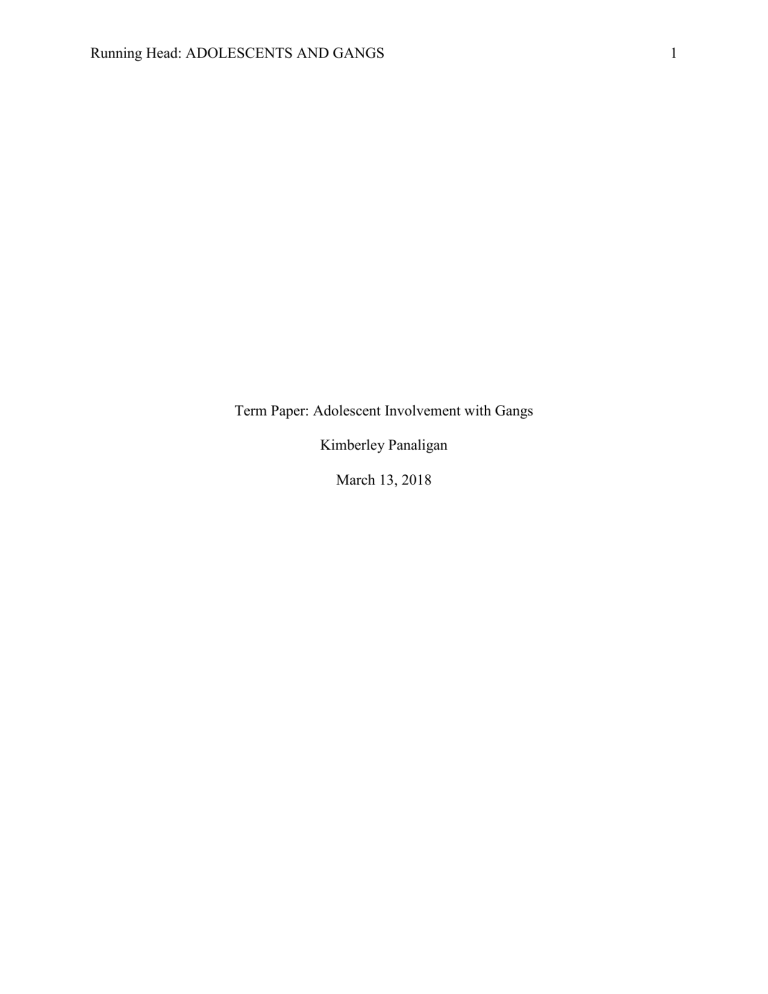
Running Head: ADOLESCENTS AND GANGS Term Paper: Adolescent Involvement with Gangs Kimberley Panaligan March 13, 2018 1 ADOLESCENTS AND GANGS 2 Gangs have been known to be a group of people involved with violent and dangerous actions and activities. Gangs are not only made up of adults, but of young adolescents as well. A news article, titled “Braden Moreton jailed for beating disabled teen” (2018), is about a 19-year old male leader of a drugs gang who harmed and robbed a man whom he thought owed him debt. Moreton was convicted of causing grievous bodily harm and robbery and was then put into jail with others involved with him in transporting drugs (“Braden Moreton jailed for beating disabled teen,” 2018). Adolescents, like Moreton, are surrounded by many influences that can socialize them into choosing to live different types of lifestyles as they grow older. They are especially in a time of their lives when they are determining which path they will take (Krohn, Ward, Thornberry, Lizotte, & Chu, 2011a). One of these lifestyles options include becoming a part of a gang—even at a young age. According to Krohn, Schmidt, Lizotte and Baldwin (2011b), becoming a part of a gang is a way for people to develop their identity. It does not only take one deciding factor, but many different reasons and factors (Dmitrieva, Gibson, Steinberg, Piquero, & Fagan, 2014), that lead to an adolescent joining in a gang (O’Brien, Daffern, Chu, & Thomas, 2013). This paper analyzes how adolescents specifically become socialized to join a gang. In examining the ways that adolescents decide to become a gang member, this paper argues that they make the decision to join a gang due to the influence of their family situations, their school environment, and their surrounding peers. Three agencies of socialization that possibly lead to the affiliation of adolescents into gangs are family, school, and peer groups (including the neighbourhoods they live in). It is claimed by Van Ngo, Calhoun, Worthington, Pyrch and Este (2017) that the gang members involved in their study experienced the weakening of their relationships and interactions with their schools, families, and surrounding peers. The accretion of stressful events in relation to ADOLESCENTS AND GANGS 3 these three agencies in the life of potential gang members are also factors that determine whether they join a gang or not (Hennigan, Kolnick, Vindel, & Maxson, 2015). Moreover, each agency socializes adolescents to possibly join a gang in several different ways. In fact, family, school, and peer groups overlap with one another in their impact to adolescent gang members. Families have a big effect on potential adolescent gang members since families are the primary caregiving groups for the youth. First of all, the adolescent’s relationship with his/her parents is very significant. Nelson, Patience, and MacDonald (1999) have claimed that students who were satisfied with the relationships they had with their parents were not so inclined to take part in deviant behaviour. On the other hand, youth who had unstable relationships with their family members were to presumably associate with peers who were more of a negative influence on their behaviours (Dupéré, Lacourse, Willms, Vitaro, & Tremblay, 2007). Secondly, ineffective parenting plays an important role in affecting the adolescents and their involvement with gangs (Blackburn, Mullings, Marquart, & Trulson, 2007). Parents with poor mental health (Van Ngo et al., 2017) and involvement with substance use can cause parents to make poor choices regarding the way they take care of and discipline their children, and so those who are adolescents can specifically be affected by becoming more antisocial and/or deviant (Dishion, Nelson, & Yasui, 2005). Additionally, adolescents who witness their parents fighting verbally or physically become exposed to violence, and thus more trauma regarding family is experienced (Van Ngo et al., 2017). Last of all, the involvement of family members in gangs also serves to be a strong influence in encouraging adolescents to become a part of gangs as well (Krohn et al., 2011b) because they become introduced to it through their primary caregiving group (Van Ngo et al., 2017). As mentioned by Van Ngo et al. (2017), adolescent gang members are negatively influenced by their family members since they are surrounded by violence in their homes, and ADOLESCENTS AND GANGS 4 therefore experience verbal and physical abuse themselves. Some other adolescents look up to their siblings who are involved in delinquent behaviours and desire to follow after them (Van Ngo et al., 2017). The aspiration to also gain respect and feel important from their gang-involved family members also encourage youth to become gang members as well (O’ Brien et al., 2013). There are also adolescents that are expected to be a part of the gang by their own family members too (Hennigan et al., 2015). Schools are also a significant agency of socialization regarding youth involvement with gangs. The influence of schools involves the role of the school system, the staff and the students within the schools. School systems that will not provide for the needs of the adolescents will interest the youth to join a gang because they are not properly being cared for (Krohn et al., 2011a). Some people that are responsible for providing these needs are the adults of the school: teachers, the principal, counselors, and the rest of the educational staff. Having a relationship with the adults at school can be a protective factor for adolescents in deciding whether to become involved with gangs or not (Ryan, Miller-Loessi, & Nieri, 2007). These relationships can positively influence the youth in displaying appropriate behaviours, doing well academically in school, and encouraging students to make wise choice regarding their future, which can help youth avoid delinquent behaviours (Ryan et al., 2007). Supportive connections with the staff of schools can also lead to creating a healthy and safe school environment for the students (Ryan et al., 2007). According to Ryan et al. (2007), the staff of schools, along with parents, are responsible for being a “first line of defense” against problems that adolescent youth can and will encounter. Therefore, if the relationships between the staff and students are poor, then the chances of the students joining into gangs would be highly probable because the students would be less likely to allow school staff to have authority over them. This situation would then lead the ADOLESCENTS AND GANGS 5 students into displaying irresponsible behaviours. Moreover, students who do not academically do well in school are prone to developing deviant behaviour by associating with other students who are not excelling in their academic studies either (Dishion et al., 2005). These situations in which students become influenced by their peers could then become “breeding grounds” that would lead adolescent students to becoming involved with gangs (Dishion et al., 2005). Making the decision to join a gang is highly associated with peer groups (Hennigan et al., 2015). The more time that youth spend with gang-involved peers, the more influenced they will be to become a part of the gang (Dishion et al., 2005). Adolescents who choose to befriend those who are already in gangs are likely to join the gang because it would be their way of hanging out with each other (Krohn et al., 2011a), even if it would be a negative influence upon their lives (Hennigan et al., 2015). Young people would also be encouraged to join gangs to get to know other people, to make more friends, and to take part in the activities that they do (O’Brien et al., 2013). As O’Brien et al. (2013) mentioned in their study, youth gangs would be more of a representation of a friendship group rather than a highly organized group. In other words, becoming a gang member isn’t just about gaining high status and getting involved with risky activities, but it is also about the friendship that they gain within being in the group as well. Peer pressure is another factor that leads adolescents into joining gangs. The pressure of peers is significantly present during the junior and senior high school years (Van Ngo et al., 2017). Students who are specifically struggling at home; experiencing difficulties academically in school; are encountering bullying, racism, and social exclusion (Van Ngo et al., 2017); and have low self-esteem and self-worth are likely to fall into peer pressure in order to gain the approval of others (Dmitrieva et al., 2014). ADOLESCENTS AND GANGS 6 Additionally, living in a disadvantaged neighbourhood with gang involvement present can also lead youth to take part in delinquent behaviour (Dishion et al., 2005; Dupéré et al., 2007). Street gangs are specifically found in neighbourhoods that are located in areas of poverty, violence and disorder (Hennigan et al., 2015). These neighbourhoods often seen to be as an unsafe environment (Blackburn et al., 2007), and so adolescents in these neighbourhoods would presumably be influenced to join gangs as a way to protect themselves and their neighbourhood (O’Brien et al., 2013). In examining the ways that adolescents decide to become a gang member, a conclusion can be made that family situations, the school environment and surrounding peers are three agencies of socialization that influence adolescents to become involved with gangs. Influencing factors within family situations include the parent-child relationship, ineffective parenting and family involvement with gangs. For the school environment, factors that influence the likelihood of adolescents in joining gangs were the system of the school, the staff-student relationship, and academic achievement. The factors that impact the youth in becoming a gang member involve the influence of friends, peer pressure, and the neighbourhoods that they live in. All in all, family, school and peer groups significantly affect adolescents in socializing them into gangs. ADOLESCENTS AND GANGS 7 References Blackburn, A.G., Mullings, J. L., Marquart, J. W., & Trulson, C. R. (2007). The next generation of prisoners. Youth Violence and Juvenile Justice, 5(1), 35-56. Braden Moreton jailed for beating disabled teen (2018, February 1), BBC News. Retrieved from http://www.bbc.com/news/uk-england-cumbria-42905296. Dishion, T. J., Nelson, S. E., & Yasui, M. (2005). Predicting early adolescent gang involvement from middle school adaptation. Journal of Clinical Child and Adolescent Psychology, 34(1), 62-73. Dmitrieva, J., Gibson, L., Steinberg, L., Piquero, A., & Fagan, J. (2014). Predictors and consequences of gang membership: Comparing gang members, gang leaders, and nongang-affiliated adjudicated youth. Journal of Research on Adolescence, 24(2), 220-234. Dupéré, V., Lacourse, E., Willms, J. D., Vitaro, F. & Tremblay, R. E. (2007). Affiliation to youth gangs during adolescence: The interaction between childhood psychopathic tendencies and neighborhood disadvantage. Journal of Abnormal Child Psychology, 35(6), 10351045. Hennigan, K. M., Kolnick, K. A., Vindel, F., & Maxson, C. L. (2015). Targeting youth at risk for gang involvement: Validation of a gang risk assessment to support individualized secondary prevention. Children and Youth Services Review, 56, 89-96. Krohn, M. D., Schmidt, N. M., Lizotte, A. J., & Baldwin, J. M. (2011). The impact of multiple marginality on gang membership and delinquent behavior for Hispanic, African American, and White male adolescents. Journal of Contemporary Criminal Justice, 27(1), 18-42. ADOLESCENTS AND GANGS 8 Krohn, M. D., Ward, J. T., Thornberry, T. P., Lizotte, A. J., & Chu, R. (2011). The cascading effects of adolescent gang involvement across the life course. Criminology, 49(4), 9911028. Nelson, B. V., Patience, T. H., & MacDonald, D. C. (1999). Adolescent risk behaviour and the influence of parents and education. Journal of the American Board of Family Medicine, 12(6), 436-443. O'Brien, K., Daffern, M., Chu, C. M., & Thomas, S. D. M., (2013). Youth gang affiliation, violence, and criminal activities: A review of motivational, risk, and protective factors. Aggression and Violent Behavior, 18(4), 417-425. Ryan, L. G., Miller-Loessi, K., & Nieri, T. (2007). Relationships with adults as predictors of substance use, gang involvement, and threats to safety among disadvantaged urban highschool adolescents. Journal of Community Psychology, 35(8), 1053-1071. Van Ngo, H., Calhoun, A., Worthington, C., Pyrch, T., & Este, D. (2017). The unravelling of identities and belonging: Criminal gang involvement of youth from immigrant families. Journal of International Migration and Integration, 18(1), 63-84.
